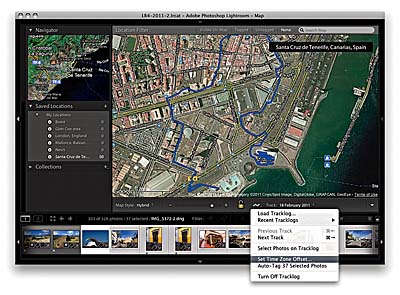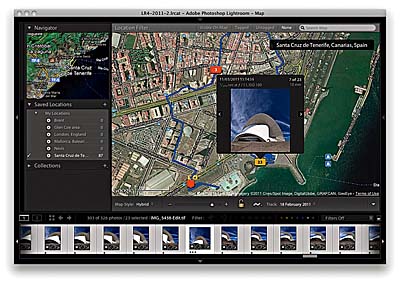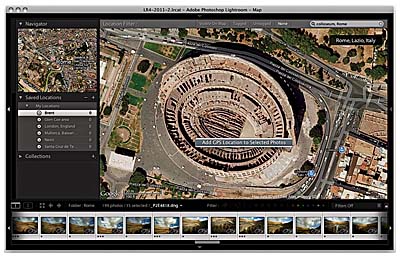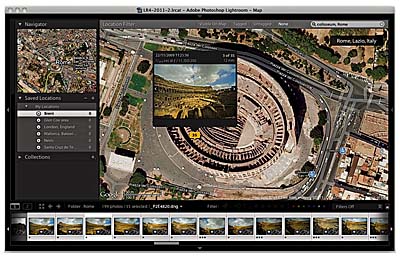Using the Map Module in Adobe Photoshop Lightroom 4
The Map module
This brings us now to the Map module (Figure 10.106), a brand-new Lightroom module for viewing and managing your geotagged images. The main content area displays a map view of the world, where there are several different map view options that you can select from via the Toolbar Map style menu (Figure 10.107). You can also use keyboard shortcuts to quickly switch map views: use  (Mac) or
(Mac) or  (PC) for Hybrid, use
(PC) for Hybrid, use  (Mac) or
(Mac) or  (PC) for Road Map, and so on. To view catalog images on the map you first need to make a photo selection, which can be done either from the Library module or via the filmstrip. The Metadata panel on the right can confirm whether GPS data is present or not and where it is, it displays the GPS coordinates (see Figure 10.105). For those images that have previously been geocoded with GPS data, clicking on the arrow next to the GPS data field (circled) centers the map location on the selected image, as does double-clicking an image in the filmstrip.
(PC) for Road Map, and so on. To view catalog images on the map you first need to make a photo selection, which can be done either from the Library module or via the filmstrip. The Metadata panel on the right can confirm whether GPS data is present or not and where it is, it displays the GPS coordinates (see Figure 10.105). For those images that have previously been geocoded with GPS data, clicking on the arrow next to the GPS data field (circled) centers the map location on the selected image, as does double-clicking an image in the filmstrip.
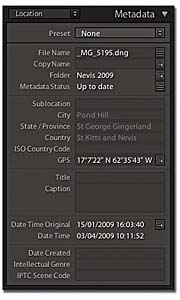
Figure 10.105. This shows a view of the Metadata panel using the Location view mode. In this example GPS data has been applied via the Lightroom Map module. Note that the IPTC location fields are filled, but they appear dimmed.
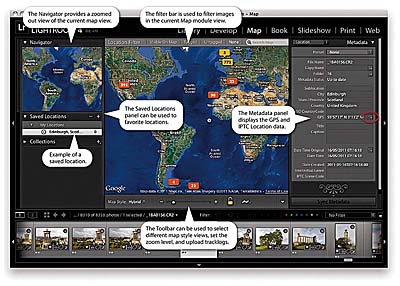
Figure 10.106. The Lightroom Map module.

Figure 10.107. The Lightroom Map module toolbar ( ) showing the available map view options.
) showing the available map view options.
Navigation
To navigate the Map module you can use the Zoom slider in the Toolbar to zoom in or out and click and drag to scroll the map view. As you do so, the Navigator panel (Figure 10.108) provides a slightly more zoomed out map view, where you can also double-click to zoom in and click-drag to scroll the map. You can also hold down the  key and drag with the cursor to define an area to zoom in to. In the Toolbar (Figure 10.107) there is the Zoom slider that can be used to control the level of zoom. Also, providing your mouse is enabled, you can use the scroll wheel to quickly zoom in and out of the map view (this also applies to the Navigator panel).
key and drag with the cursor to define an area to zoom in to. In the Toolbar (Figure 10.107) there is the Zoom slider that can be used to control the level of zoom. Also, providing your mouse is enabled, you can use the scroll wheel to quickly zoom in and out of the map view (this also applies to the Navigator panel).
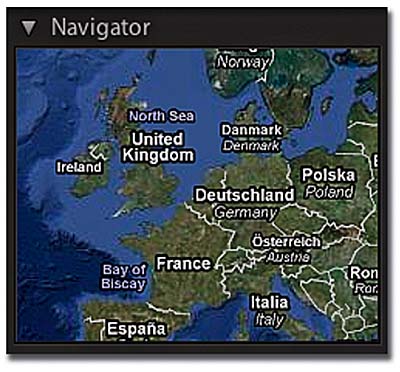
Figure 10.108. The Navigator panel.
Location filter bar
The filter bar ( ) (Figure 10.110) works very much like the one in the Library module. It is used to filter the filmstrip contents to create a filtered sub-selection of the current Library module selection. If you click on the “Visible on Map” option, this populates the filmstrip with just those photos that are geocoded and appear within the current map view. As you zoom in fewer photos will be selected and as you zoom out more photos will be selected. If you click on the “Tagged” option this filters the filmstrip, to select the geotagged photos only, dimming the untagged photos. If you click on the “Untagged” option this selects all the images that have yet to be geotagged within the current selection and dims all the rest. This is particularly useful if you wish to filter out the images that need to be geotagged manually in the Map module. The default “None” option applies no filter to the Filmstrip and lets you select all of the filmstrip images.
) (Figure 10.110) works very much like the one in the Library module. It is used to filter the filmstrip contents to create a filtered sub-selection of the current Library module selection. If you click on the “Visible on Map” option, this populates the filmstrip with just those photos that are geocoded and appear within the current map view. As you zoom in fewer photos will be selected and as you zoom out more photos will be selected. If you click on the “Tagged” option this filters the filmstrip, to select the geotagged photos only, dimming the untagged photos. If you click on the “Untagged” option this selects all the images that have yet to be geotagged within the current selection and dims all the rest. This is particularly useful if you wish to filter out the images that need to be geotagged manually in the Map module. The default “None” option applies no filter to the Filmstrip and lets you select all of the filmstrip images.
The Search field allows you to search the Google Maps database to find a specific place. Very often a single place name will suffice when making a search. Otherwise, use a comma when entering a place name hierarchy. So for example, you might want to specify searching for Las Vegas, New Mexico if you did not want the search to default to Las Vegas, Nevada. Or, if you are not sure of an exact location (or you are aware that there might be more than one place associated with a specific search), you’ll see a pop-up list of suggestions, allowing you to select whichever is the correct, desired location (see Figure 10.109).
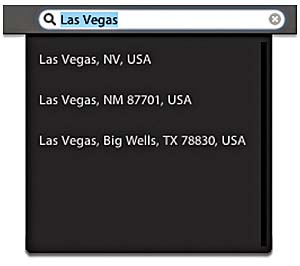
Figure 10.109. A location search can offer suggestions where more than one location is associated with a specific search.
Figure 10.110. The Location filter bar. Use a backslash ( ) to toggle on or off.
) to toggle on or off.
Loading GPX tracklogs
You can import tracklogs (GPX only) via the tracklog icon in the Toolbar (circled in Figure 10.111) or by going to the Map menu and choosing Tracklog  Load Tracklog... Once a tracklog has been loaded, Lightroom searches to see if any photos in the current catalog selection have date times that match with the times recorded to the tracklog. Where matches are found, Lightroom gives you the opportunity to auto-tag the matching photos so they effectively become geotagged in Lightroom.
Load Tracklog... Once a tracklog has been loaded, Lightroom searches to see if any photos in the current catalog selection have date times that match with the times recorded to the tracklog. Where matches are found, Lightroom gives you the opportunity to auto-tag the matching photos so they effectively become geotagged in Lightroom.
Figure 10.111. An example of loading files to a tracklog.
You can also drag a photo from the filmstrip to a point on the tracklog that you believe to be the right location for that photo. Do this and all the other photos should auto-tag accordingly (see Figure 10.112). This allows you to quickly auto-tag photos regardless of any time zone differences, but it’s dependent on your being able to recognize a particular location on the map, which isn’t always easy. Overall, I reckon it is best to make sure you have the correct time set on your camera to match that on your computer and time shift the GPS data (if necessary) as you load a tracklog.
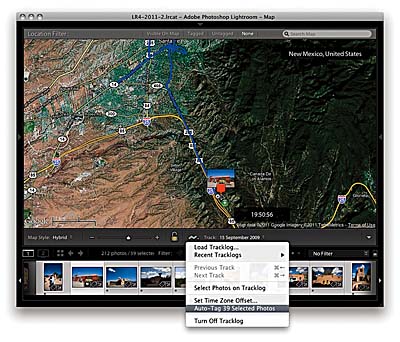
Figure 10.112. If you are unsure of the time zone difference, you can also drag a photo to a known point on a tracklog and then select other photos to auto-tag to the tracklog.
Matching photos to a recorded tracklog
The following steps show an example of how I was able to load a GPX tracklog and ensure that the photos matched correctly when autotagging them.
- In this first step I clicked on the tracklog button circled in Figure 10.111 and loaded a GPX tracklog. Having done this, the GPS tracklog route showed up in the Map module map view as a blue route. Before I used this to tag the photos shown selected in the filmstrip, I wanted to check that the selected photos matched the same time zone as was recorded by the tracklog.
- Essentially, the tracklog is always correct. What isn’t always correct though is the date time set in the camera and thus the date time that’s embedded in the capture image files. The objective here is to work out just what that time difference might be. If you think your camera is correctly set, taking into account daylight saving time, you can proceed to Step 3. Otherwise, go to the Tracklog menu shown open in Step 1 and select “Set Time Zone Offset...” If the camera times appear not to match, the tracklog time will display in red. As you adjust the Offset slider, you’ll know when you are close to the correct setting when the tracklog time is displayed in black.
- Once the time zone had been set correctly, all I had to do was to select the photos in the fIlmstrip and choose Auto Tag Selected Photos from the tracklog menu. This matched up the photos to the tracklog and displayed them as shown here.
Editing pins
Figure 10.113 shows some examples of how the pins may appear when viewed in the Map module. A basic pin marker for a single image will be shown as an empty orange pin marker. As you roll the mouse over the pin, you will see it change, adding four arrows, which indicates that you can click and drag to alter the position of that pin. Note that doing this will overwrite the original GPS metadata, which might be a problem if you end up removing the original recorded GPS position. It is possible to lock the solo pins by clicking on the lock button in the Toolbar, but this means you won’t then be able to edit the positions of any of the other solo pins until you remove the lock. If you click on a pin to select it, the pin turns yellow, indicating that it is active and the image is selected in the filmstrip. If more than one image is geotagged at a specific location, the number of photos are displayed in the pin. Note here that the number in the pin and the number of pins will vary according to the Map module magnification view. For example, as you zoom out the Map view will adjust to show fewer pins, grouping more of the pins together into group clusters. When I view photos in my Lightroom catalog I’ll see lots of pins dotted around all over London, but if I zoom out far enough these are grouped under a single pin group marker. To reposition a pin group, you need to click on it to select the photos in the filmstrip. You can then drag those photos from the filmstrip to reposition them on the map.
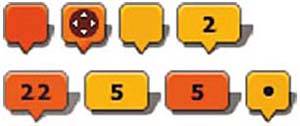
Figure 10.113. This shows examples of pin appearance in the Map module. From left to right and top to bottom: an orange pin indicates a single unselected geotagged photo. When you click on a point, the active arrows indicate you can drag to reposition if required. A yellow pin indicates a single photo currently selected in the filmstrip. A yellow rectangular pin with a number inside it indicates there are a number of selected photos shot at the exact same location. An orange pin with a number inside it indicates a number of unselected photos shot at the exact same location. A yellow rectangle with a number inside and no pointing arrow indicates a cluster of selected nearby photos. An orange rectangle with a number inside and no pointing arrow, indicates a cluster of unselected nearby photos. A pin with a black dot represents the result of a Map search.
Whenever you click on a pin the corresponding image will appear selected in the filmstrip, and as I already mentioned, the pin will turn from orange to yellow. If you click on a pin you will see the thumbnail or thumbnails associated with that pin. If there is more than one photo just click on the arrows in the thumbnail preview to see the images associated with that particular pin position (Figure 10.114). Lastly, you can use  (Mac) or
(Mac) or  (PC) to lock/unlock a pin’s position.
(PC) to lock/unlock a pin’s position.
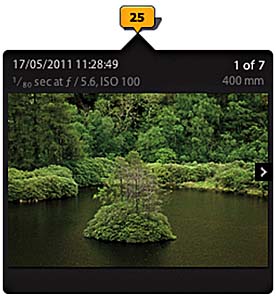
Figure 10.114. Clicking on a pin selects it, and a second click (or initial double-click) reveals the thumbnail or thumbnails associated with that location. Subsequent clicks on other pins will reveal the thumbnails, also if you simply hover the cursor over a pin.
Manually geotagging photos in the Map module
For all those photos in your catalog that haven’t been geocoded, you can do so manually by dragging individual photos or selections of photos from the filmstrip to a location on the map, or hold down the  (Mac) or
(Mac) or  (PC) key and click on the map to geotag the selected photos. As you do so you will see that a pin marker is added to the map view (Figure 10.115). This is a great solution for geotagging photos that don’t have any recorded GPS data. However, I would urge you to think carefully when manually tagging photos this way. For the data to be useful and conform with the way GPS data is normally recorded, you need to tag as near as possible the exact location where the photo was taken and not the location of the subject of the photo.
(PC) key and click on the map to geotag the selected photos. As you do so you will see that a pin marker is added to the map view (Figure 10.115). This is a great solution for geotagging photos that don’t have any recorded GPS data. However, I would urge you to think carefully when manually tagging photos this way. For the data to be useful and conform with the way GPS data is normally recorded, you need to tag as near as possible the exact location where the photo was taken and not the location of the subject of the photo.
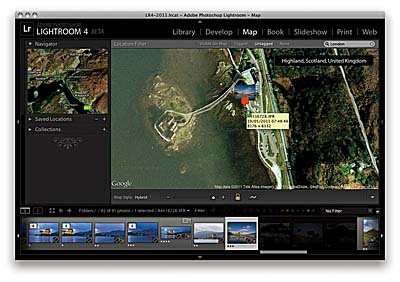
Figure 10.115. Placing a pin marker manually via drag and drop from the filmstrip.
If you right-click anywhere in the Map module you’ll see an “Add GPS Location to Selected Photos” menu option. This allows you to manually geotag photos by making a selection in the filmstrip first and then use the above contextual menu to geotag the selected photos. You can also use this contextual menu to “Delete GPS Coordinates.”
- In this example, I made a selection of photos via the filmstrip and right-clicked in the Map view to select “Add GPS Location to Selected Photos.”
- After doing this, the selected photos were geotagged accordingly.
Permanently reverse geocoding images
When you geocode images manually in the way I just described, you’ll notice that the IPTC location fields in the Metadata panel are filled automatically, but only if none of the location fields is empty to begin with and only if you have reverse geocoding enabled in the Metadata section of the Catalog Settings (see page 623). If any of the fields already has information, Lightroom won’t auto-populate them with new location data (even though the new data might be more accurate). You will also notice that where images have been manually geotagged the text appears grayed rather than white. This indicates that the metadata information you have just added is not permanent yet and can be updated should you make further edits to the placement of the pin location. In other words, you have the option to fine-tune the position of any manually added pins and the location metadata will update accordingly. This metadata is still valid and will be included in any export, but it remains editable while you are working in Lightroom. If you wish, you can make this IPTC location data permanent. As is shown in Figure 10.116, this does mean that you will have to click on the location field names one by one and select the current temporary name to activate it to make the field entry permanent. This then locks the location metadata. From there on, if you need to update the location you will have to do so manually.
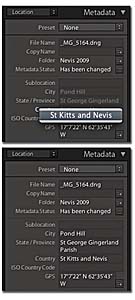
Figure 10.116. In the top Metadata panel view I was able to make the Country location metadata field applied through manual geocoding in Lightroom more permanent by clicking on the “Country” name and highlighting the name (in this case, “St Kitts and Nevis”). This has to be done to each of the Location fields in order to make the data entry permanent. Of course, you can still edit these fields in the same way as usual, but you won’t be able to update them when moving the pin position. Note that If you disable the reverse geocoding in the Metadata section of the Catalog settings and then enable it again, you will need to restart Lightroom for this to kick in.
Exporting GPS encoded files
Whenever you export a photo from Lightroom the GPS data is normally saved with it, along with all the other XMP data associated with the image. However, there are ways now that you can specifically strip the GPS metadata (if you want to know the reasons why you might want to do this, see my comments on page 632). One way you can do this is to check the “Private” box in the New Location dialog when creating a new location (see Figure 10.120). Or, you can right-click in the Saved Locations panel to reveal the contextual menu and choose “Location Options...” to open the Edit Location dialog and enable the Private GPS data option. When you do this the GPS data will from now on be excluded on export from all photos contained within that radius. The other method can be found in the Export dialog. If you go to the Metadata section (shown in Figure 10.117) you will see a check box marked “Remove Location Info.” This allows you to strip the GPS metadata for all the photos that are included in a Lightroom export.

Figure 10.117. The Metadata section of the Export dialog, where you can check the “Remove Location Info” option to exclude all Location EXIF metadata on export.
Saved Locations panel
The Saved Locations panel (Figure 10.118 and Figure 10.119) allows you to store favorite locations and thereby make managing the Map module easier. All you have to do is click on the arrow to the right of a saved location and the Map module will instantly switch to display this location in the map view (then use  to toggle the circumference display on or off). To create a new location, make sure the current map view is centered on an area of interest and click on the plus button at the top of the panel. This opens the New Location dialog shown in Figure 10.120, where you can set a radius for the location and choose a folder to save the new location to. Once a location has been saved you can edit the radius by dragging on the circumference pin shown in Figure 10.121.
to toggle the circumference display on or off). To create a new location, make sure the current map view is centered on an area of interest and click on the plus button at the top of the panel. This opens the New Location dialog shown in Figure 10.120, where you can set a radius for the location and choose a folder to save the new location to. Once a location has been saved you can edit the radius by dragging on the circumference pin shown in Figure 10.121.
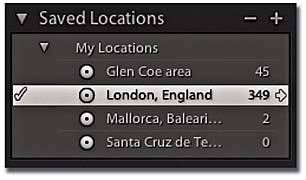
Figure 10.118. The Saved Locations panel.
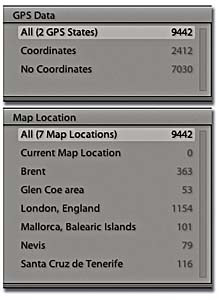
Figure 10.119. This shows the GPS Data Metadata filter that allows you to filter according to GPS status. Below this is the Map Location filter. Both are available as filter options in the Library module filter bar.
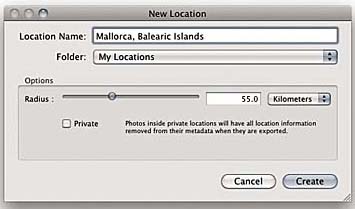
Figure 10.120. The New Location dialog.
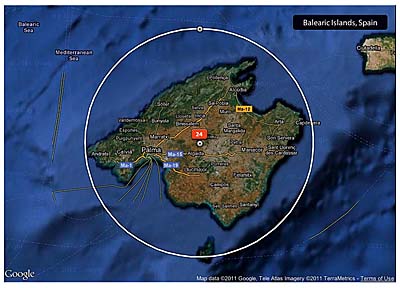
Figure 10.121. This shows the radius of a saved location in the main Map view. Note that it is possible to edit the saved location radius by dragging the circumference pin (shown at the top of the circle).
